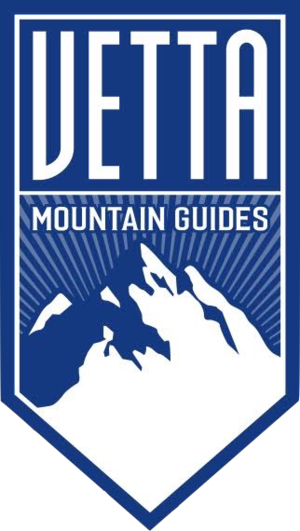This blog originally appeared on Elevation Outdoors, June 15, 2012. Rob and Vetta co-founder, Mike Arnold, have since both achieved international certification through the IFMGA.
Talking to climbers and reading online forums, I consistently hear about the “AMGA way.” A recent post on mountainproject.com got me thinking about this subject (again) and I thought I’d write something on it. For the record, I have taken my beginning rock, alpine, and ski courses, passed my “Single Pitch Instructor” exam (though, come to think of it, I think my cert is lapsed in that discipline–oops!), and I just passed my aspirant exam in ski mountaineering, all through the American Mountain Guides Association–or the mythic AMGA. I’m headed towards my full certification (I hope!) through the International Federation of Mountain Guides Associations (IFMGA; or your “international” cert, basically). I am by no means a representative of the AMGA, any more than a “normal guide” is–I don’t teach for the AMGA, write on its behalf, etc.
Bottom line: though I’d say I’m pretty immersed in the process at this point, this here’s just the opinion of one dude going through the program.
Second bottom line: there is no “AMGA way.” I’ve heard the contrary a lot on courses and at cliffs–“oh, I heard the AMGA way is…” or “hey, what’s the AMGA way?” In doing my courses I’ve run across a couple old-school guides who preferred (quite strongly!) doing things in certain ways, but the vast majority of guide instructors I’ve worked with haven’t had or taught “a way.” There are practices one experiences repeatedly, but I’m trying to think of a course in which one of the instructors or examiners said, “You must do it this way…”
And I can’t.
They hammer certain principles into our heads, though: safety, speed/efficiency, client enjoyment, stuff like that, and in that order. As long as it’s safe, hopefully saves you some time (and doesn’t cost you any!), and your clients are having a blast–party on, brothers and sisters.
My most recent course in Valdez, Alaska, brought this general point home to me when doing my sled-rescue drill. I had been practicing it all winter and when I showed up my examiner, Vince Anderson, said everything looked cool, but he asked me a few questions: why didn’t I just “Munter pop” when doing my knot pass; why not just feed the knot through your Munter; how about setting your releasable hitch on the load strand rather than the brake side?
I don’t want to go fully into the sled-rescue exercise and its details, but my point is Vince was encouraging us to think within the context of skiing and snow, rather than a full-on rock-rescue exercise. We might have way less gear with us during a day of skiing. The potential load forces are generally, but not always, lower than in a rock setting. He said everything I was doing was fine safety wise, but towards efficiency I could improve my exercise.
The over-arching maxim for technical systems within the AMGA, seems to me, is “the right tool at the right time.” This can lead to some frustration, as an examiner might ding a student for using a technique that is arguably not quite appropriate at that particular moment, but the principle also leaves the door open to creative solutions to often complex situations and problems.
Is a single locking carabiner sufficient when clipping in to the rope on a glacier? How about on non-crevassed, but snowy terrain? A two-point anchor in alpine terrain, rather than a full-on three-point equalized rig? How about when a storm’s approaching? Are two locking carabiners “standard” on a toprope system’s master point, or a single non- and single locker?
The above questions might solicit several different solutions and answers, depending on the day, the time, the guide, the climbers, and the situation. Part of the fun and challenge of the AMGA process is filling one’s tool-box with as many techniques as possible, but the real finesse and elegance in guiding is knowing when to pull which one out and put it into practice. Just as important: when NOT to pull out the fancy stuff and let your routefinding, pacing, coaching, modeling, and communication improve safety and the experience.
Again, I am by no means a spokesman for the AMGA and I’m still a ways off of my IFMGA cert, but I spend a lot of time with guides and I’m way down the rabbit hole in terms of courses, so I have some perspective on this “AMGA way.” I don’t think it exists…unless you tack a little “s” on to the end of way…and then you’re on to something. Safe, efficient, and happy climbing!










